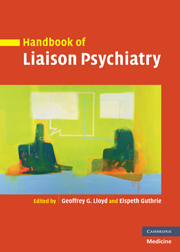Book contents
- Frontmatter
- Contents
- List of contributors
- Preface
- Part I Basic skills
- Part II Common psychiatric problems across the general hospital
- Part III Working with specific units
- 14 Neurological disorders
- 15 Cardiorespiratory disorders
- 16 Gastrointestinal disorders
- 17 Liver disorders
- 18 Endocrine disorders
- 19 Diabetes
- 20 HIV and AIDS
- 21 Renal disease
- 22 Musculo-skeletal disorders
- 23 Oncology
- 24 Head and neck cancer
- 25 Palliative care
- 26 Cosmetic procedures
- 27 Perinatal and gynaecological disorders
- 28 The intensive care unit
- 29 The burns unit
- 30 Psychocutaneous disorders
- 31 Genitourinary disorders
- 32 The emergency department
- Part IV Treatment
- Part V Different treatment settings
- Index
- References
14 - Neurological disorders
from Part III - Working with specific units
Published online by Cambridge University Press: 10 December 2009
- Frontmatter
- Contents
- List of contributors
- Preface
- Part I Basic skills
- Part II Common psychiatric problems across the general hospital
- Part III Working with specific units
- 14 Neurological disorders
- 15 Cardiorespiratory disorders
- 16 Gastrointestinal disorders
- 17 Liver disorders
- 18 Endocrine disorders
- 19 Diabetes
- 20 HIV and AIDS
- 21 Renal disease
- 22 Musculo-skeletal disorders
- 23 Oncology
- 24 Head and neck cancer
- 25 Palliative care
- 26 Cosmetic procedures
- 27 Perinatal and gynaecological disorders
- 28 The intensive care unit
- 29 The burns unit
- 30 Psychocutaneous disorders
- 31 Genitourinary disorders
- 32 The emergency department
- Part IV Treatment
- Part V Different treatment settings
- Index
- References
Summary
Introduction
In practice the psychiatrist working in a clinical neurosciences centre is likely to have to address three main categories of clinical problems on a daily basis:
patients with cognitive impairment either as a primary presentation or as a secondary complication of a known condition, such as multiple sclerosis
patients who present with neurological disease but in whom there is emotional disturbance in excess of the clinical norm
patients who present with physical symptoms which do not correspond to any recognized pattern of neurological disease.
The approach to such cases should include a neuropsychiatric as well as a standard psychiatric assessment. The neuropsychiatric assessment depends upon the observation that predictable patterns of symptoms will result from damage to specific brain areas. The summary of the clinical assessment should include not only a ‘headline’ diagnosis but also a clinical problem list of the impairments and consequent disabilities that the patient suffers (Table 14.1). It is often the latter that will dictate the management of the individual patient. For example, a psychiatrist will seldom make the diagnosis of multiple sclerosis (MS) but will be frequently asked to assess patients with MS and to comment on their cognitive impairment, depressive and other emotional disorders and maladaptive coping strategies.
Treatments, and in particular psychological treatments, are not discussed in detail as they are covered in other chapters. Whilst we have described specific drug therapies the reader should be aware that in many neuropsychiatric conditions the mainstays of patient management are behavioural and environmental manipulation.
Keywords
- Type
- Chapter
- Information
- Handbook of Liaison Psychiatry , pp. 305 - 364Publisher: Cambridge University PressPrint publication year: 2007
References
- 3
- Cited by



